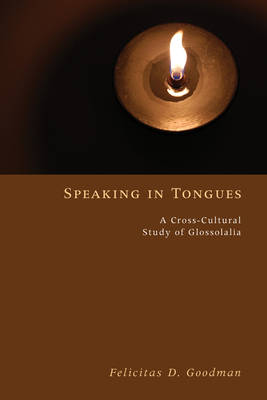
- Afhalen na 1 uur in een winkel met voorraad
- Gratis thuislevering in België vanaf € 30
- Ruim aanbod met 7 miljoen producten
- Afhalen na 1 uur in een winkel met voorraad
- Gratis thuislevering in België vanaf € 30
- Ruim aanbod met 7 miljoen producten
Zoeken
Omschrijving
Speaking in tongues, or glossolalia, is practiced in many different religions around the world. Dismissed as meaningless gibberish by some observers, it has been the subject of only a few fragmentary studies. The work of Felicitas D. Goodman represents the first cross-cultural analysis of this enigmatic behavior, and she brings to her research an extensive background in linguistics and anthropology. Dr. Goodman's fieldwork included living with apostolic congregations in Mexico City, in the Yucatan with Maya Indians, and visits with a congregation in Hammond, Indiana. Her observations were preserved on a remarkable collection of sound recordings and films. For this book she presents a selection of conversion stories that highlights the personality structure and experiences of the speakers. A detailed analysis of the phonological and suprasegmental features of the recorded utterances show a surprising cross-cultural agreement. This led Goodman to believe that glossolalists speak the way they do because their speech behavior is modified in a particular mental state, often termed trance, into which they place themselves. In this light the glossolalia utterance is seen as an artifact of a hyperaroused mental state, or, in Chomskyan terms, as the surface structure of a nonlinguistic deep structure, that of the altered state of consciousness. Goodman describes the hyperaroused mental state as a neurophysiological phenomenon, as well as the associated patterns of movement, and the problems of waking from it. Goodman's diachronic approach yielded equally surprising data about the changes and the waning of the behavior over time. But, as she observes, ""we have barely touched the edge of a very large area of inquiry."" Her fascinating study opens a number of new avenues of research for anthropologists, such as the study of physiological states accompanying linguistic and ritual behavior.
Specificaties
Betrokkenen
- Auteur(s):
- Uitgeverij:
Inhoud
- Aantal bladzijden:
- 198
- Taal:
- Engels
Eigenschappen
- Productcode (EAN):
- 9781556358531
- Verschijningsdatum:
- 15/04/2008
- Uitvoering:
- Paperback
- Formaat:
- Trade paperback (VS)
- Afmetingen:
- 130 mm x 203 mm
- Gewicht:
- 213 g

Alleen bij Standaard Boekhandel
+ 77 punten op je klantenkaart van Standaard Boekhandel
Beoordelingen
We publiceren alleen reviews die voldoen aan de voorwaarden voor reviews. Bekijk onze voorwaarden voor reviews.











